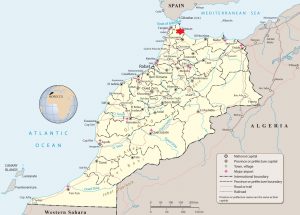Tetouen
Tetouan, nicknamed White Dove, was settled in the late 15th century by Muslims and Jews from southern Spain. Tétouan was expanded when it became the capital of the Spanish protectorate in Morocco between 1913 and 1956. We heard more Spanish here along with French and Arabic. Tétouan is famed for its fine craftsmanship and musical activities. Within the buildings the ceilings are often carved and painted and the tile work of the floors and columns is in Spanish Moorish designs reminding us of the Alhambra of Granada. It is sometimes called “little Granada.”
We made a day trip from Chefchaouen to Tetouan. We walked along a pedestrian walkway noting the Spanish influence in architecture. On the plaza we saw the Nuestra Señora de las Victorias Catholic church along with the royal palace. There were a number of boys carrying wooden slates with some Arabic written on them. Our guide said they were showing that they were learning the Koran and wanted money for their work! He talked with one boy who did quite well in reading what he had written and then recited it.
- reservoir
- hillside
- dam
- White Dove
- Spanish influence
- boy reading his slate
- boy reciting
- government building
- Catholic church
- Spanish influence
- opposite royal palace
- around the royal palace circle
- royal palace entrance
- side street
We toured the medina with all its wonderful foods and crafts and again noting the Spanish and Jewish influences.
- entrance to Jewish quarter
- shoes
- thread bobbins
- fish
- walkway
- tailor
- chickens
- eggs
- dates
- game of marbles
- olives
- Jewish building from late 1800s
We stopped at a technical school. We had hoped to see the students in action, but it was their first day and they were just getting organized. The school is free to students who have dropped out of ordinary school. A program requires 4 years of study. The students learn a craft and then are apprenticed to a professional worker. We saw the classrooms for those in wood carving and talked to two students who are in their second year.
- water fountain near the entrance to the kasbah
- an entrance to the kasbah
- looking out towards technical school
- entrance to technical school
- courtyard of technical school
- two students
- instrument in museum
- embroidery exhibit (in cabinet)
- ceiling design
- carving pattern
- table example
- tables
- entrance from courtyard
Our lunch was in a restaurant along the coast. We picked out the fish we wanted and it was grilled and brought to the table. Good!
- choice of fish
- fish served
Our route back to Chefchaouen was first along the coast and then through mountains and beautiful gorges. The coast was very foggy but still nice.
- coast
- housing along coast
- coast
- coast
A lot of “weed” is grown unofficially in northern Morocco. We saw fields and fields of it interspersed with corn and beans. At one place we stopped and our guide talked to the farmer. Our guide went in the field and picked some and brought it on the bus for us all to see. The picture many of us will remember is of the farmer doing his prayers beside his truck while our guide talks to his helper about the plant.
- hillside
- farmer’s fire (burned 65 acres)
- valley
- mountains
- isolated village
- isolated village
- waterfall
- river
- mountains
- mountains
- canyon
- green valley
- corn, beans, “weed”
- guide talking to farmer’s helper
- marijuana
- mountains
- sheep herding
- countryside
We gathered for an evening meal in a nearby restaurant. (Only 7 of the 9 are visible.)
- supper

































































